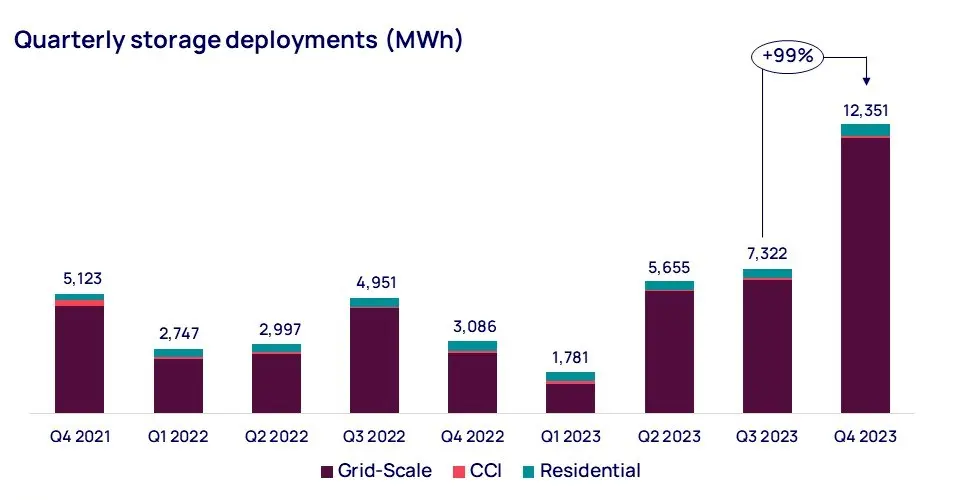In-Depth Analysis Exclusive Insights! How Large a Storage Battery Do U.S. Users Need

How large a storage battery do U.S. users need?
How should product specifications be designed for the U.S. market?
This article will provide an in-depth analysis and answers to the above questions.
"Big Size" is More Popular
Before diving into the analysis, let's look at an interesting question:
The representative product in the U.S. market is Tesla's Powerwall. Each Powerwall battery has a capacity of 13.5 kWh and weighs up to 130 kg. It is bulky and heavy, which seems like a "user-unfriendly" design!
The size of the battery users need mainly depends on household electricity consumption. According to data from the U.S. Energy Information Administration, in 2023, the average annual electricity consumption of U.S. households was 10,788 kWh, with an average monthly consumption of 899 kWh.
When choosing the battery size, we generally consider the daily electricity consumption to ensure that the battery can maintain power supply for a day in the event of a power outage. Based on this principle, the battery size should be:
899 ÷ 30 days ≈ 30 kWh
In reality, solar power can supply electricity during the day, and the battery is needed at night. Therefore, the required battery size can be reduced by 30%.
30 × 70% = 21 kWh
Additionally, considering system efficiency issues, the battery cannot be fully charged and discharged, and the future performance degradation of the battery should also be considered. Thus, the battery size should be 25-28 kWh, which is approximately the size of two Powerwall batteries.
This is why larger batteries are more popular in the U.S. market, while Europe prefers smaller battery modules. U.S. households consume more electricity, and smaller batteries are "not enough," making it more cumbersome to install multiple modules at once.
Large Batteries are More Common in the U.S, Europe Prefers Smaller Battery Modules.
The above is a general analysis and not the complete truth. Let's analyze further.
Significant Differences Across States
The U.S. has 50 states with vast and sparsely populated areas. Household electricity consumption varies greatly across states. In general, the northeastern regions use the least electricity, while the southern states use the most. Southern households use more electric heating and air conditioning.
Let's take a closer look at California. California is the largest market in the U.S., with solar installations five times that of the second-largest state and more than the combined total of the second to eighth largest states. It can be said, "Whoever wins California wins the market."
What is the Situation in California?
In 2023, the average annual electricity consumption of California households was 6,420 kWh, with an average monthly consumption of 535 kWh, or about 18 kWh per day, which is below the national average.
Applying the previous analysis, we can conclude that the battery size should be 13-15 kWh, which is precisely the size of one Powerwall battery.
This also aligns with actual market data. In 2023, the median size of storage systems in California was 13 kWh.
The 10 kWh Rule
Ultimately, batteries need to power household appliances, so let's continue the analysis from the perspective of electrical appliances.
The top three uses of electricity in U.S. households are air conditioning (19%), heating (12%), and water heating (12%). Almost every household has air conditioning, and 67% of households have central air conditioning.
Additionally, almost all households (99%) have a refrigerator, and 34% have two or more. Particularly in the Midwest, the proportion of households with more than two refrigerators is higher. During a power outage, other appliances can be turned off, but the refrigerator cannot be stopped. If a power outage causes food in the refrigerator to spoil, the loss would exceed $200.
Here are some common household appliances:
| Device | Power Consumption |
|---|---|
| Air Source Heat Pump | 3500W |
| TV | 300W |
| Refrigerator | 200W |
| Lights * 5 | 5 * 20W |
| Mobile Charger | 25W |
| WiFi Router | 6W |
These appliances can run simultaneously. However, to save electricity during a power outage, we usually make trade-offs. For example, if we want the refrigerator to run for three more hours, we can reduce television time by two hours. If we plan to keep essential appliances (phone, computer, WiFi, refrigerator, and some lights) running during a power outage, a 10 kWh battery can power these devices for about 24 hours.
This is why the average battery size of leading U.S. brands is around 10 kWh. For example, Enphase's battery size is 10.08 kWh, and SolarEdge's battery size is 9.7 kWh.
Other Considerations
Finally, let's look at two special scenarios.
Scenario 1: Increasing Solar Self-Consumption Ratio
Users want to maximize the use of green solar power and reduce grid electricity costs.
In 2023, the average installed capacity of solar systems in the U.S. was 11.3 kW. The highest was in Kentucky, with an average size of 14.5 kW. The smallest was in California, at 8.07 kW (but California has better sunlight conditions, resulting in longer effective generation time). Assuming 4 hours of daily solar generation, this can produce 32-44 kWh.
Since 70% of household electricity consumption occurs at night, we need to store the excess daytime generation, requiring 20-30 kWh of batteries. This equates to 2-3 units of 10 kWh batteries.
Scenario 2: Completely Off-Grid
Off-grid needs are more complex, as we must consider extreme situations.
Take Arizona as an example. In Arizona, we must prepare for the hot summer when air conditioning will run at full capacity. Arizona has ample sunlight, with 7.5 hours of daylight during summer. The average household monthly electricity consumption is 1,050 kWh, or 35 kWh per day.
Long daylight hours mean we don't need to install large solar systems, but for safety during cloudy days, the battery should be sufficient to power the house for three days:
35 * 3 = 105 kWh
This would require approximately 8 Powerwall batteries or 10 Enphase batteries.
Conclusion
Based on the above analysis, we can see that designing individual batteries with a capacity of 10-13 kWh is a good choice. By parallel connecting multiple batteries, different needs can be met.
Related Blogs
-
![blog_pic]() 03/20/2025
03/20/2025SolaX Micro-Grid Solutions- Enabling Reliable Solar Power in All Conditions
As solar energy adoption grows, the demand for reliable, resilient, and efficient
-
![blog_pic]() 02/14/2025
02/14/2025Maximize Solar Energy Efficiency with SolaX Global MPP Technology Best MPPT Inverters for Partial Shading
Harnessing the power of innovation, SolaX proudly introduces its cutting-edge Global Maximum
-
![blog_pic]() 02/22/2024
02/22/2024Market Report 12.35 GWh U.S. Energy Storage Installation Hits Record High Again
Recently, "U.S. Energy Storage Monitor" released its latest report. In the fourth
Join Our Newsletter
Keep yourself updated with latest news and updates









